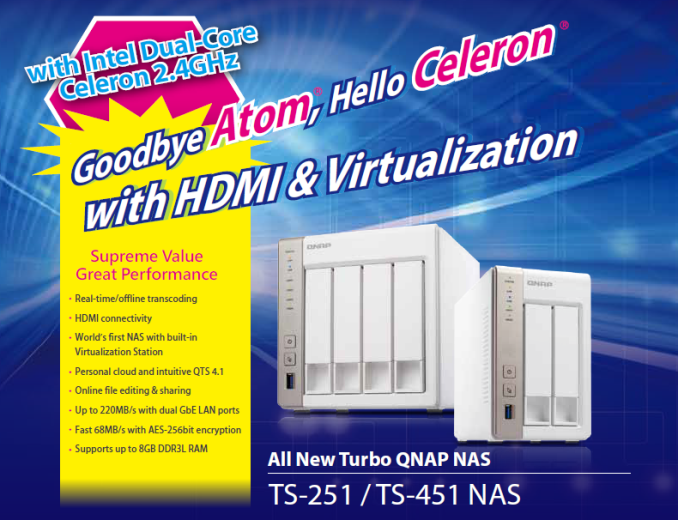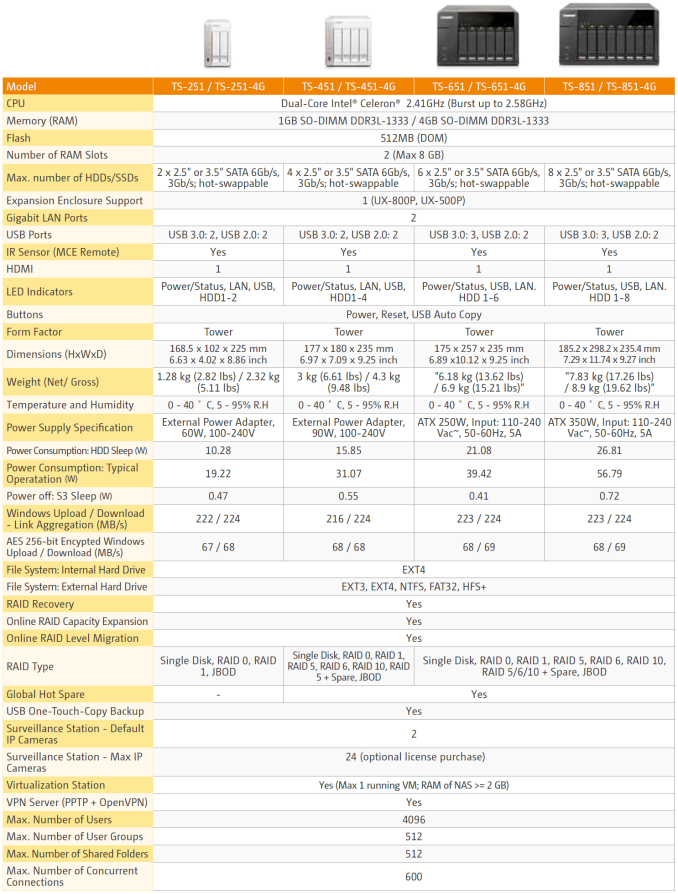QNAP TS-x51 NAS Series: Intel Quick Sync Gets its Killer App
by Ganesh T S on June 22, 2014 6:45 PM EST
Introduction
At Computex 2014, we visited QNAP and came away with a lot of information (some of which we had already seen at CES). After Computex, QNAP got in touch with me to better explain the various features of the newly introduced TS-x51 series (which was not at CES). And, boy, was I floored?! Usually, you don't see me getting very excited over product announcements. They usually get a small write-up with analysis in our pipeline section. However, I believe that QNAP's TS-x51 family has the capability to revolutionize the NAS market for home users and media enthusiasts, particularly in the way it utilizes Intel Quick Sync technology. It also gives us an opportunity to understand the state of the market and where it is headed.
The consumer / SOHO / SMB NAS market (which, in our definition, is comprised of units costing less than $5K) has two major platform vendors. In the cost-sensitive low power / performance segment, we have Marvell, with its ARM-based SoCs. Units requiring higher processing power (where cost is not a primary factor) have typically utilized Intel's x86 platforms. Over the last year or so, the delineation has been blurring quite a bit. Marvell's ARMADA 370 is no slouch when it comes to CPU performance, and it integrates a healthy number of PCIe and SATA lanes. On the other hand, Intel realized that its Bonnell-based D525 and D27xx-based solutions for the NAS market (which required an additional PCH) were not particularly power or cost efficient. While announcing its Silvermont architecture last year, Intel mentioned that the Bonnell follow-up would be part of multiple SoCs for microservers (Avoton) as well as other infrastructure equipment (Rangeley). It was widely expected that NAS vendors would move to Silvermont soon for their x86-based units. We were expecting some announcements at CES, but there was really nothing new.
QNAP's TS-x51 series has been introduced into the market just as it is on the verge of a major change. The details of the various members of the TS-x51 series are provided below. The Celeron CPU mentioned in the first row happens to be the J1800.
Before analyzing the product line and its features, let us take a short detour to understand Intel's play in this market.











49 Comments
View All Comments
ganeshts - Monday, June 23, 2014 - link
To Intel's defense, they never claimed it would be part of Bay Trail, actually.But, I do agree that they could have created new part numbers instead of just stepping changes. I have asked Intel for comment, and will update the piece when they respond.
beginner99 - Monday, June 23, 2014 - link
After seeing the pricing a DIY looks like a very sweet deal again...ryanmt - Monday, June 23, 2014 - link
Yeah... for me, the value prospect of a DIY is in the next-gen file systems with the atomic-COW, bit-level versioning, etc. Until the vendors get on that bandwagon, I don't think they'll get my business.rocktober13 - Monday, June 23, 2014 - link
Maybe I missed it, but will Plex use QuickSync if installed on the QNAP? Or does QS only work with QNAP's apps?ganeshts - Monday, June 23, 2014 - link
QS will work only with QNAP's apps. (Qfile and built-in media server)rocktober13 - Monday, June 23, 2014 - link
Thanks, I think the adoption of QS is great, but I still think the one or two apps I might use aren't worth the price premium over a DIY NAS.Netscorer - Monday, August 11, 2014 - link
Thanks. This & the price makes it a no-go for me. Yet another 'Multimedia' NAS where 1+1 does not equal 2, as they have video transcoding and Plex server but not the two together.For now it's still cheaper to buy no-thrills 4-bay NAS fronted by Haswell-based HTPC. You get full Windows on TV, better performance, full-featured (and fully-supported) Plex plus better upgrade flexibility.
snakyjake - Monday, June 23, 2014 - link
I have five main concerns before I'll consider a NAS:1) If a small file is accessed, do all drives spin up?
2) Data integrity. There's a difference between drive failure and bad data blocks found from a drive surface scan.
3) Is my data stored in a propriety format?
4) Upgradability. I can't afford to keep purchasing a new complete system. And what about new vendor software?
5) Cost.
OpenMediaVault, FreeNAS, UnRaid, FlexRaid, are very easy. Windows Home Server used to be a viable option too.
I'm just not willing to let my data become hostage to a proprietary vendor, without assurances.
ganeshts - Monday, June 23, 2014 - link
All the popular NAS vendors who offer off-the-shelf NAS boxes use software RAID (except for Drobo, whom we have never covered on this site in a review as yet). This means you can take out all the drives, image them and mount on a PC. After that, you could just use something like UFS Explorer to recover the data.For 'bad blocks', I have usually seen vendors reallocate without proclaiming drive failure. They do sound a warning in the logs, though (Again, haven't tested for all vendors)
I have never seen these NAS vendors charge for OS upgrade (that said, sometimes the OS is quite 'demanding' and 4 - 5 year old models are not capable of running the upgraded version).
(1) and cost vary from vendor to vendor, I guess.
mannyvel - Monday, June 30, 2014 - link
< This means you can take out all the drives, image them and mount on a PC>Has anyone actually attempted to do this and get it to work?